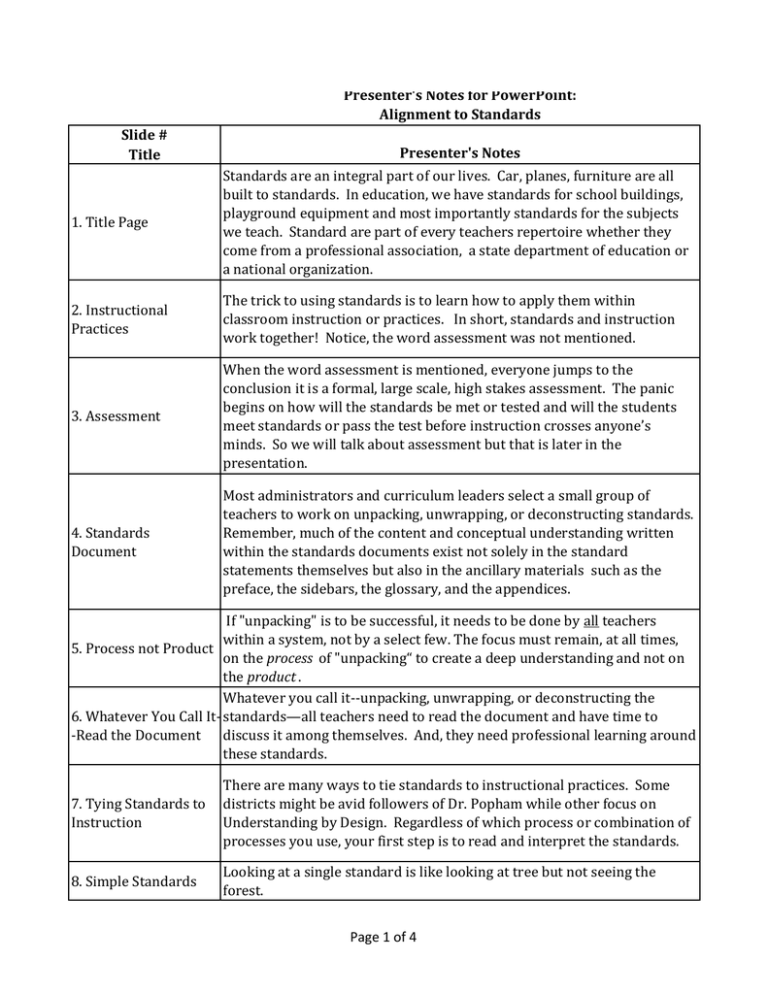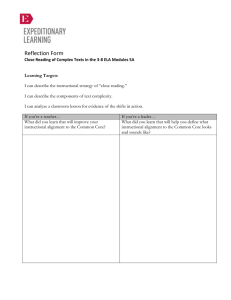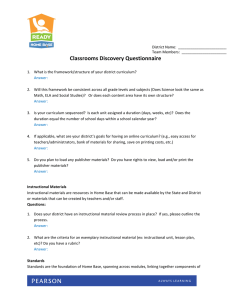Presenter`s Notes for PowerPoint: Alignment to Standards Slide
advertisement

Presenter's Notes for PowerPoint: Alignment to Standards Slide # Title Presenter's Notes 1. Title Page Standards are an integral part of our lives. Car, planes, furniture are all built to standards. In education, we have standards for school buildings, playground equipment and most importantly standards for the subjects we teach. Standard are part of every teachers repertoire whether they come from a professional association, a state department of education or a national organization. 2. Instructional Practices The trick to using standards is to learn how to apply them within classroom instruction or practices. In short, standards and instruction work together! Notice, the word assessment was not mentioned. 3. Assessment When the word assessment is mentioned, everyone jumps to the conclusion it is a formal, large scale, high stakes assessment. The panic begins on how will the standards be met or tested and will the students meet standards or pass the test before instruction crosses anyone’s minds. So we will talk about assessment but that is later in the presentation. 4. Standards Document Most administrators and curriculum leaders select a small group of teachers to work on unpacking, unwrapping, or deconstructing standards. Remember, much of the content and conceptual understanding written within the standards documents exist not solely in the standard statements themselves but also in the ancillary materials such as the preface, the sidebars, the glossary, and the appendices. If "unpacking" is to be successful, it needs to be done by all teachers within a system, not by a select few. The focus must remain, at all times, 5. Process not Product on the process of "unpacking“ to create a deep understanding and not on the product . Whatever you call it--unpacking, unwrapping, or deconstructing the 6. Whatever You Call It- standards—all teachers need to read the document and have time to -Read the Document discuss it among themselves. And, they need professional learning around these standards. 7. Tying Standards to Instruction There are many ways to tie standards to instructional practices. Some districts might be avid followers of Dr. Popham while other focus on Understanding by Design. Regardless of which process or combination of processes you use, your first step is to read and interpret the standards. 8. Simple Standards Looking at a single standard is like looking at tree but not seeing the forest. Page 1 of 4 9. Multiple Standards Statements Upon reflection , it is easier to see the forest--a set of standards working together to prompt higher order thinking and reasoning, problem solving, and critical and creative thought. This synergy often leads to the standard statement being greater than the sum of its individual parts. Additionally, these standards are built upon an integrated model of student learning where individual standard statement often comment on, contribute to, and help to solidify the learning addressed in other standard statements. 10. Ways to clarify "less-than-lucid" content standards: Some standards are easier to understand than others. Dr. Popham suggests when standards are difficult to understand: convene a small group of educators to deliberate and attempt consensus about what is meant by the standards under consideration, and consider the deliberations of other content specialists. Slow down and take time to have teachers of all content areas collaborate to create observation tools such as rubrics, checklists, review forms that 11.Take Time to Learn address standards. Then provide time for them to visit one another's Standards classrooms to use these tools to observe the instructional practices of their colleagues. 12. Essential Question: What does the context Also, Dr. Popham poses the essential question: What does the content standard expect of standard expect of students? students? Popham advises, teachers must dig into the viscera of a given content standards with the intention of better understanding what that standard 13. Popham Advises: seeks from students .” In short digging into the guts of a problem is not easy. Again, time and professional learning are vital tools to help with the digging. 14. Alignment with Standards Another piece of advice when examining standards it to determine what the standards seek from students. What does the standard say students should know and understand, what should the be able to do? 15. Habits of the Mind Additionally, what habits of the mind to students demonstrate when they have mastered the standards. 16. What "Habits of mind" do students demonstrate when they have measured the standard? Please take a moment to read the 16 Habits of the Mind which are so important when working with students. Pick one to reflect upon by yourself. Page 2 of 4 17. Photo 18. 16 habits of the Mind Source 19. Understanding by Design (UbD) -a curriculum design model that focuses on what we teach My pick is persistence. We know in order to achieve, students need to be persistent. If the text gets complicated and they are struggling to read the material, they must persist in learning it. If the math is hard, they need to persist in learning it. They cannot give up! In case you want the source, here it is! Do we want an activity or one from Habit of the mind site. Understanding by Design(UbD) –a curriculum design model that focuses on what we teach. It can use a backward design which starts with what the end result will be, what students should know, understand and be able to do. Or it can design down by identifying identify one or more ‘learning progressions’ that students can pursue—in any order that works--as they develop mastery of the content standard Other Questions From Understanding by Design are: • What are the big ideas represented in the standard? • What questions are to be explored in the standard? Once we have a clear understanding of standards including what they 21. Seamless mean in terms of instructional practices for the teacher, it is them time to Alignment: Standards think about assessment. Teachers want a seamless alignment system to to Assessments standards and assessments. 22. Seamless According to Stiggins, it is necessary to provide a clear vision of the Alignment: Standards learning target with samples of proficient and non-proficient work so to Assessments Cont. students can see a progression to competence laid out before them. 20. Other questions From UbD 23. Seamless And, teachers need to provide students with continuous access to Alignment: Standards descriptive (versus evaluative or judgmental) feedback—information that to Assessments Cont. helps them see how specifically to improve the quality of their work 24. Seamless Alignment: Standards to Assessments Cont. 25.Seamless Alignment: Standards to Assessments Cont. 26. Advantages to Using A variety of Assessment Method toe Exemplify Curricular Content Stiggins add another major piece to seamless alignment is to engage students in repeated self-assessments so they can watch themselves successfully negotiating the steps to competence. n/a Advantages to Using a Variety of Assessment Methods to Exemplify Curricular Content include: a) Provides students with the opportunity to demonstrate mastery of curriculum in the way that works best for them. b) If the teacher uses all the methods with all the students, the teacher can see how mode of assessment affects student performance and the extent and nature of student misunderstandings of the concept. Page 3 of 4 27. Instructional Sensitivity of Test Makes Content Standards Accessible Popham reminds teachers that the key attributes of instructionally sensitive tests are that they: The key attributes of instructionally sensitive tests are that they: Measure 28. Modest Number of students’ mastery of only a modest number of curricular aims or of Curricular Aims exceptionally important ones—so teachers aren’t overwhelmed by too many instructional targets. 29. Contain a sufficient Contain a sufficient number of items measuring each curricular aim—so number of items the tests effectively report on each student’s achievement in terms of each measuring curricular assessed aim.” aim 30. Teacher Friendly Language for Descriptions of Skills Provide teacher-palatable descriptions of the skills or bodies of knowledge being assessed—so teachers can direct their instruction toward those assessment targets rather than toward particular test items. In conclusion, there is a rich variety of assessment types to match or tie to standards. The link to the standard and assessment is the instructional 31. Assessment Types practices selected and used by the classroom teacher. Many test types are available so please examine modules included in the Assessment Literacy program. 32. Alignment to Standards: Activity n/a One Page 4 of 4


